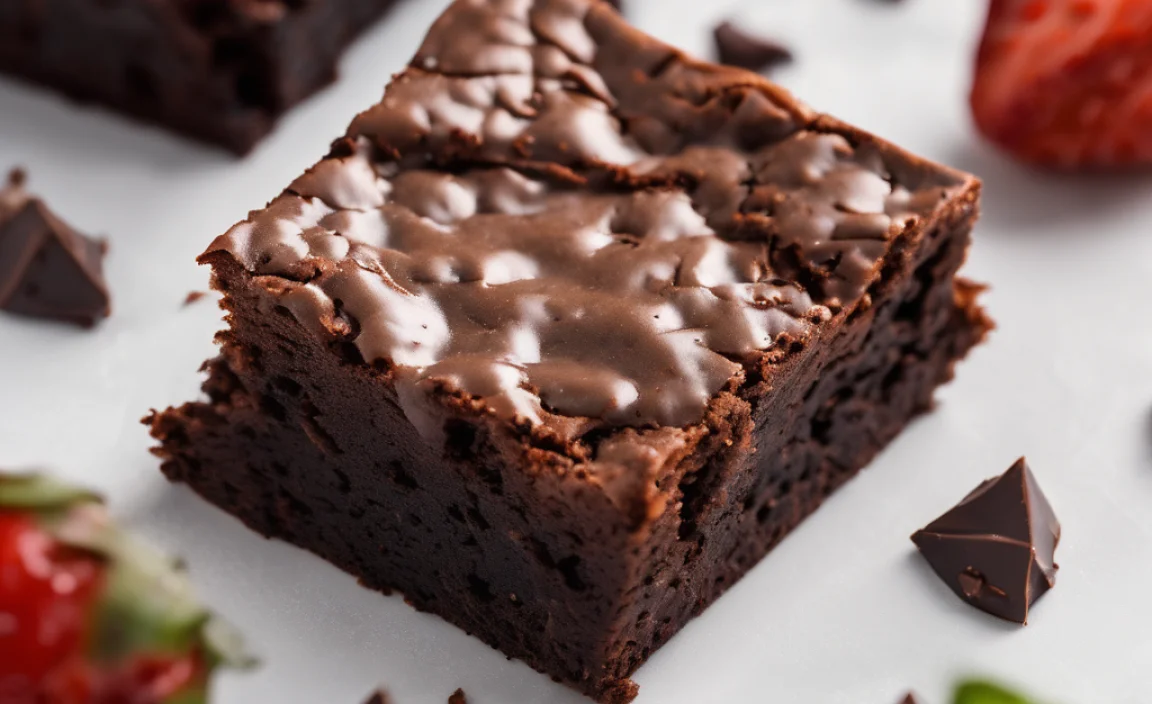Your brownies probably sank because of underbaking, too much liquid, or overmixing. Don’t worry! It’s a common baking problem. We’ll show you simple fixes to get perfectly fudgy brownies every time. Follow our easy steps, and you’ll be baking like a pro in no time.
Ever pull your brownies out of the oven, excited for that perfect, fudgy square, only to find a sunken center staring back at you? It’s frustrating, right? You followed the recipe (or so you thought), and now you’re left with a baking mystery. Don’t toss them just yet!
Sinking brownies are a common baking mishap, and the good news is it’s usually easy to fix. In this guide, we’ll walk you through the most common causes of sunken brownies and give you simple, step-by-step solutions. Get ready to say goodbye to sunken centers and hello to brownie perfection!
Ready to get started? First, let’s look at the usual suspects behind those sinking brownies. We’ll cover everything from oven temperature to mixing techniques, and even give you some pro tips for perfect brownies every time.
Understanding Why Brownies Sink

Before we dive into the fixes, let’s understand the main reasons why your brownies might be sinking. Knowing the “why” makes it easier to prevent this from happening again. Think of it like diagnosing a simple problem before it becomes a major issue. Here are the top culprits:
- Underbaking: This is the most common reason. The center isn’t fully set and collapses as it cools.
- Overtemperature issues: Oven temperature not calibrated right causes the brownies to sink.
- Too Much Liquid: Extra liquid throws off the batter’s balance, leading to a soggy, sunken center.
- Overmixing: Overmixing develops too much gluten, which can cause the brownies to rise too much and then collapse.
- Incorrect Pan Size: Using the wrong pan size can affect baking time and how evenly the brownies cook.
- Altitude: High altitude can affect baking times and cause baked goods to rise and fall.
Now that we know the common causes, let’s get into the solutions! We’ll tackle each issue one by one, giving you practical tips to avoid sunken brownies in the future.
Step-by-Step Solutions to Prevent Sinking Brownies

Here’s a detailed guide to fixing each of the common causes of sunken brownies. Follow these steps, and you’ll be enjoying perfectly baked brownies in no time!
1. Bake at the Right Temperature and Duration
The Problem: Underbaking is the number one reason for sunken brownies. If the center isn’t fully cooked, it will collapse as it cools.
The Solution:
- Use an Oven Thermometer: Oven temperatures can vary. An oven thermometer ensures your oven is at the correct temperature. You can purchase one from any local departmental store or online.
- Check for Doneness: Insert a toothpick into the center of the brownies. It should come out with a few moist crumbs attached, not wet batter.
- Bake a Little Longer: If the toothpick comes out with wet batter, bake for a few more minutes and check again.
- Follow the Recipe: Adhere to the baking time as stated in the recipe and make adjustments based on your oven.
2. Measure Ingredients Accurately
The Problem: Too much liquid can disrupt the batter’s structure, causing the center to sink.
The Solution:
- Use Measuring Cups and Spoons: Don’t eyeball it! Use proper measuring tools for both dry and liquid ingredients.
- Level Dry Ingredients: When measuring flour and sugar, spoon them into the measuring cup and level off the top with a knife.
- Measure Liquid at Eye Level: When measuring liquids, use a liquid measuring cup and check the level at eye level to ensure accuracy.
- Double-Check the Recipe: Make sure you’re using the correct measurements. It’s easy to misread a recipe!
3. Avoid Overmixing the Batter
The Problem: Overmixing develops too much gluten, which can cause the brownies to rise excessively and then collapse.
The Solution:
- Mix Until Just Combined: Mix the wet and dry ingredients until they are just combined. A few streaks of flour are okay.
- Use a Rubber Spatula: Switch to a rubber spatula for the final mixing. This helps prevent overmixing.
- Don’t Overbeat: Avoid using a mixer on high speed for too long. Gentle mixing is key.
4. Use the Correct Pan Size
The Problem: Using the wrong pan size can affect baking time and how evenly the brownies cook. Deeper pans require more baking time, which can lead to the edges becoming overcooked while the center remains undercooked.
The Solution:
- Use the Recommended Pan Size: Always use the pan size specified in the recipe.
- Adjust Baking Time if Necessary: If you have to use a different pan size, adjust the baking time accordingly. Smaller pans may require less time, while larger pans may need more.
- Check for Doneness Regularly: Regardless of the pan size, check for doneness using the toothpick test.
5. Adjust for High Altitude
The Problem: High altitude can affect baking times and cause baked goods to rise and fall due to lower air pressure.
The Solution:
- Increase Oven Temperature: Increase the oven temperature by 25°F (15°C).
- Reduce Baking Powder: Reduce the amount of baking powder by 1/4 teaspoon.
- Increase Liquid: Add 1-2 tablespoons of extra liquid to the batter.
- Reduce Sugar: Reduce the amount of sugar by 1 tablespoon.
6. Cooling Properly
The Problem: Cutting brownies while they are still hot can make the center sink or become gooey.
The Solution:
- Let Brownies Cool Completely: Allow the brownies to cool completely in the pan before cutting them. This can take an hour or two.
- Refrigerate for Faster Cooling: If you’re in a hurry, you can refrigerate the brownies for faster cooling.
- Use a Sharp Knife: Use a sharp knife to cut the brownies cleanly.
Troubleshooting Common Brownie Problems

Sometimes, even when you follow the recipe perfectly, things can still go wrong. Here are some common issues and how to troubleshoot them:
Problem: Brownies are too dry
Solution:
- Add a tablespoon or two of milk or water to the batter.
- Make sure you’re not overbaking them.
- Store the brownies in an airtight container to prevent them from drying out.
Problem: Brownies are too gooey
Solution:
- Bake them a little longer.
- Use less liquid in the batter.
- Let them cool completely before cutting.
Problem: Brownies are too cakey
Solution:
- Use more fat (butter or oil) in the recipe.
- Use less flour.
- Don’t overmix the batter.
Problem: Brownies are too hard
Solution:
- Don’t overbake them.
- Add more fat to the batter.
- Store them in an airtight container to keep them soft.
Tips for Perfect Brownies Every Time

Here are some extra tips to ensure your brownies turn out perfectly every time:
- Use High-Quality Ingredients: Better ingredients make better brownies. Splurge on good chocolate and butter.
- Prepare the Pan: Grease and flour the pan or line it with parchment paper for easy removal.
- Melt Chocolate and Butter Properly: Melt chocolate and butter slowly and evenly to avoid burning. A double boiler is ideal.
- Don’t Overbake: Brownies continue to cook as they cool, so it’s better to slightly underbake them than overbake them.
- Experiment with Flavors: Add nuts, chocolate chips, or other mix-ins to customize your brownies.
- Cool Completely: Resist the urge to cut into them while they’re still warm. Cooling is essential for the right texture.
The Science of Baking: Why Ingredients Matter

Baking is a science, and understanding how ingredients interact can help you bake better brownies. Here’s a quick look at the role of key ingredients:
| Ingredient | Role in Brownies |
|---|---|
| Flour | Provides structure. Too much makes brownies cakey, too little makes them gooey. |
| Sugar | Adds sweetness and moisture. It also affects the texture and browning. |
| Butter/Oil | Adds richness and moisture. It also affects the texture and tenderness. |
| Eggs | Bind ingredients together and add structure. They also contribute to the rise. |
| Chocolate | Adds flavor and richness. The type of chocolate affects the overall taste. |
| Baking Powder | Leavening agent that helps brownies rise. Use sparingly to avoid a cakey texture. |
Understanding these roles can help you adjust recipes and troubleshoot problems more effectively.
Creative Brownie Variations
Once you’ve mastered the basics, why not try some creative variations? Here are a few ideas to get you started:
- Peanut Butter Swirl Brownies: Swirl peanut butter into the batter before baking.
- Salted Caramel Brownies: Top the brownies with a layer of salted caramel.
- Cream Cheese Brownies: Swirl cream cheese into the batter for a tangy twist.
- Mint Chocolate Brownies: Add mint extract and chocolate chips for a refreshing flavor.
- Espresso Brownies: Add a shot of espresso to the batter for a coffee kick.
Tools You’ll Need for Perfect Brownies
Having the right tools can make baking brownies easier and more enjoyable. Here’s a list of essential tools:
- Mixing Bowls: For mixing wet and dry ingredients.
- Measuring Cups and Spoons: For accurate measurements.
- Rubber Spatula: For gentle mixing.
- Whisk: For combining wet ingredients.
- Baking Pan: The correct size for your recipe.
- Parchment Paper: For lining the pan and easy removal.
- Oven Thermometer: To ensure accurate oven temperature.
- Toothpick: For checking doneness.
- Sharp Knife: For cutting clean slices.
How to Store Brownies Properly
Proper storage can keep your brownies fresh and delicious for days. Here’s how to store them:
- Airtight Container: Store brownies in an airtight container at room temperature.
- Layer with Parchment Paper: If stacking brownies, layer them with parchment paper to prevent sticking.
- Refrigerate for Longer Storage: For longer storage, refrigerate the brownies. They may become slightly firmer, but they’ll stay fresh longer.
- Freeze for Extended Storage: To freeze brownies, wrap them tightly in plastic wrap and then in foil. They can be frozen for up to 3 months.
Safety Tips for Baking
Baking should be fun and safe. Here are some safety tips to keep in mind:
- Use Oven Mitts: Always use oven mitts when handling hot pans.
- Keep a Clean Workspace: Keep your work area clean and free of clutter.
- Supervise Children: If baking with children, supervise them closely.
- Be Careful with Hot Liquids: Handle hot liquids carefully to avoid burns.
- Turn Off the Oven: Always turn off the oven after baking.
FAQ: Common Questions About Brownies
Here are some frequently asked questions about baking brownies:
- Why are my brownies cakey instead of fudgy?
- Cakey brownies are usually caused by too much flour or overmixing the batter. Reduce the amount of flour and mix until just combined.
- Can I use oil instead of butter in brownies?
- Yes, you can use oil instead of butter. Oil will result in a more moist and chewy brownie. Use an equal amount of oil as butter.
- How do I know when my brownies are done?
- Insert a toothpick into the center of the brownies. It should come out with a few moist crumbs attached, not wet batter.
- Can I add chocolate chips to my brownie batter?
- Absolutely! Chocolate chips are a great addition to brownies. Add them to the batter after mixing the wet and dry ingredients.
- Why did my brownies burn on the edges?
- Burnt edges can be caused by baking the brownies at too high a temperature or for too long. Use an oven thermometer to ensure accurate temperature and check for doneness regularly.
- How can I make my brownies more fudgy?
- To make fudgy brownies, use more fat (butter or oil) and less flour. Also, consider using melted chocolate instead of cocoa powder.
- Can I freeze brownie batter for later use?
- Yes, you can freeze brownie batter. Store it in an airtight container or freezer bag. When ready to use, thaw it in the refrigerator overnight.
Conclusion
So, next time your brownies sink in the middle, don’t panic! You now have the knowledge and tools to troubleshoot and prevent this common baking mishap. Remember to measure accurately, avoid overmixing, bake at the right temperature, and let them cool completely. Baking perfect brownies takes practice, but with these tips, you’ll be well on your way to brownie perfection. Now go ahead, preheat that oven, and bake a batch of delicious, perfectly textured brownies. Happy baking!



